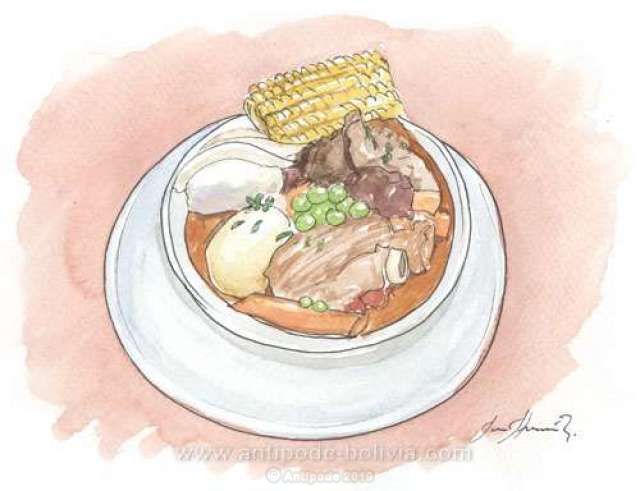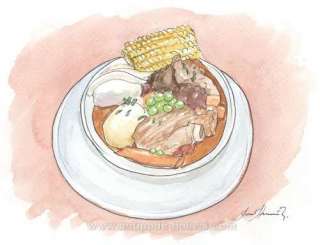

Bolivian gastronomy
Despite a weak international notoriety, the Bolivian gastronomy keeps for the good cook lovers some sweet surprises.
Each region has its own specificities,
and the table reflects the cultural identity of each department. However, you
cannot leave Bolivia without testing these following dishes:
Obviously, potato (be careful; « papa » in Spanish). This
tuber has a lot of variations according to the dishes, salsas, variety… It
really is the Andean basic food. In Cochabamba, the local proudness is aji de papalisa.
For the curious, try the chuño,
this dried potato is often eaten in the high lands, where food conservation
becomes hard because of the cold climate.
Never potato without meat. And for sure they love meat in
Bolivia! In anticucho (skewers with
small pieces of heart, chicken or beef meat, macerated in vinegar and grilled
with a potato on the top), or in chicharron (pieces of grilled or fried pork, mainly in markets). For vegetarian people, it
will be quite difficult to eat because the meat is everywhere in Bolivian
dishes. Parrilladas (barbecues) are
common and much appreciated. In Cochabamba, ask for a pique macho, spicy steak with French fries, onions and others.
In the Andes, they are used to eat cuy… our guinea pig! Not for faint-hearted, the entire body is
served, with head and paws. Obviously, do not miss to taste lama’s meat,
deliciously tender, because you will not find it at your return in the
supermarket.
The other unforgettable of the Bolivian food is soup.
Traditionally, it is the only meal of the day, and it is the compulsory step to
each Menu in a small “restaurant” (even the big ones). In La Paz, taste chairo, you will have in a terracotta
bowl the famous chuño previously
mentioned, lamb meat, beef and charque (dried
and salted meat).
There also is sopa de quinoa, sopa de mani (peanuts),
laqua de choclo (corn cream)… Kalapurka is also worth to taste, literally, the hot stones’ soup. It
is a heavy soup made of violet corn and seasoned with an herb called chachacoma, served with in the middle a
stone, heated in embers, which cooks the soup.
Some specialties to snack or to have breakfast: the empanada, kind of slipper stuffed with
minced meat, chicken, cheese, served warm. It is also called salteña when it is the special Bolivian
recipe (because you can find empanada
all over Latin America), which is with meat, potato, egg, green peas, onion,
olive, sometimes dried grape and carrot, and a lightly spiced sauce.
Another simple pleasure at 10 am, the tamal or humita for the
vegetarian one, corn slipper stuffed with meat, vegetables and spices.
Then, it is to know that there are a few deserts, an almuerzo or a menu at the market or a cafeteria, that is served with the
appetizer (soup) and a refreshment, almost never includes desert.
Never mind, markets are full of fruits like mango, chirimoya (big green fruit with white
pulp, particularly tasty), tuna (small
colored fruit growing on cactus – prickly pear), maracuya (passion fruit, excellent in juice), but the best is to
leave for adventure and discover by own-self the yellow and thorny ocoro, the round guaraypuru, violet and green, and all the other rare fruits that
will surprise you through the Bolivian markets.
Concerning drinks, beginning with drinks without alcohol, the
most typical is obviously the mate de
coca, infusion of coca leaves, excellent for altitude sickness, digestion,
oxygenation of the body, etc… Another local infusion is api, made of red milled corn, very sweet. Yungas’ coffee, Arabica,
which Bolivian people drink with a lot of sugar, is really good. Mocochinche is made of cane sugar juice,
cinnamon and peach. And finally, evidently, all kind of fruit juices, sold
almost everywhere.
Beware of alcohol at altitude: it goes to your head much more quickly. A great alcoholic specialty are cocktails made with Singani, a kind of Bolivian grappa, at 43%, made from grapes. Others include the Chuflay (with ginger ale or sprite and lemon) or the Yungueño (with orange juice). But when Bolivians drink, it's mostly with beer or strong spirits. Each city has its own brand of beer: Paceña, blond or brown, for La Paz; Sureña, light, in Sucre; Cruceña in Santa Cruz; Potosina, somewhat robust; Huari, with a rather unusual taste, in Oruro... Peasants, during festivals, prefer aguardiente or puro, a fearsome local spirit. Finally, in the Andes and also in Cochabamba, chicha, made from fermented corn and also found in Peru, is widely consumed. Bolivia produces good wine; the Tarija region, in the extreme south of the country, is full of surprises - and good grape varieties. The tradition of wine-making dates back to the arrival of the Jesuits, who planted the first vines in 1606 for their cult. Mizque, the seat of the archbishops during the colony, soon became a major wine producer, but it wasn't until the 1970s that a wine industry began to emerge. In the last ten years, major investments have been made to import new grape varieties; today, Bolivia produces Cabernet Sauvignon, Malbec, Barbera and Merlot; white wines include Riesling, Franc Colombard and Chardonnay. At this altitude (between 1,600 and 2,400 m), the grapes develop rich aromas, due to more intense exposure to ultraviolet light than elsewhere. This is what gives Bolivian wine its distinctive character.



